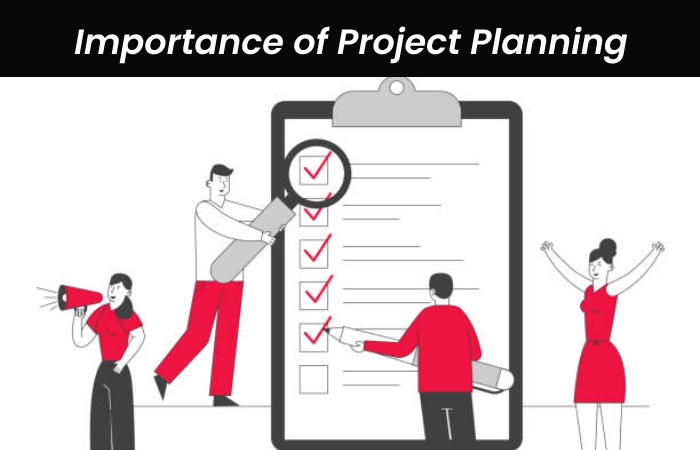Share This Article
About Project Planning
Project planning is a discipline addressing how to finish a project in a specific period, for the most part, with characterized stages and assigned assets. One perspective on project planning separates the action into these means:
- setting quantifiable targets
- distinguishing expectations
- scheduling
- planning errands
Supporting plans might envelop HR and communication strategies and hazard the executives. Enterprises frequently have a statistics innovation project planning that recognizes the cycles utilized. Thus, tools utilized for the booking portions of an arrangement incorporate Gantt outlines and PERT charts.
Importance of Project Planning

Project planning is vital at each period of a project. It spreads out the essentials of a project, including the accompanying:
- scope
- goals
- objectives
- plan
Planning empowers project managers to transform an immaterial thought into the real world. Thus, critical reasons for planning incorporate the accompanying:
- work with communication and give a focal wellspring of data for project faculty;
- assist the project with supporting and other vital partners realize what is required;
- distinguish who will play out specific tasks and when and how those tasks will occur;
- work with the project executives and control as the project advances;
- empower compelling checking and management of a project;
- Manage project risk, and
- produce feedback valuable for the following project planning stage.
What are the Components of a Project Plan?
The three significant pieces of a project plan are the extension, budget, and timeline. In addition, they include the accompanying aspects:
- The extension figures out what a project group endlessly won’t do. It takes the group’s vision, partners’ needs, and the consumer’s prerequisites and then figures out what’s conceivable. As a feature of characterizing the project scope, the project chief should set execution objectives.
- Project managers look at what labor and different assets will likely meet the project objectives to gauge the project’s expense.
- It uncovers the timeframe expected to finish each project period and also, incorporates a timetable of achievements we receive.
How Would You Make a Project Plan?
Project planning incorporates the accompanying ten stages:
- Characterize Stakeholders: Stakeholders remember anybody with an interest in the project. They can include the client or end client, individuals from the project group, others in the association the project will influence, and outside associations or people with interest.
- Characterize Roles: Every partner’s job ought to be categorized. Specific individuals will fill various roles, be that as it may.
- Present Stakeholders: Keep a gathering to bring stakeholders intact and bring together the vision behind the project. The subjects should incorporate scope, goals, budget, schedule, and roles.
- Set Goals: Take what is gathered from the gathering and refine it into a project plan. Moreover, it should incorporate goals and expectations that characterize the outcome of the item or administration.
- Focus on Tasks: List tasks essential to meet goals and focus on them in light of significance and interdependencies. For example, a Gantt graph can be helpful for planning project conditions.
- Make A Schedule: Lay out a timeline that considers the assets required for every one of the tasks.
- Survey Risks: Recognize project risks and foster systems for alleviating them.
- Communicate: Share the arrangement with all stakeholders and give communications refreshes in the organization and also, the recurrence stakeholders anticipate.
- Reconsider: As achievements have come across, return to the project plan and also, re-examine regions not measuring up to assumptions.
- Last Assessment: When the project is complete, execution should assess to gain experience and recognize regions to move along.
What are Project Planning Tools and Programming?
Project planning and project executives’ programming work with the project planning process. The best tools support joint effort among stakeholders, have natural UIs and give results in time following and invoicing.
Some project planning programming tools incorporate the accompanying:
- Asana offers different project perspectives to suit a group’s inclinations.
- ClickUp accompanies a few Lithe-based highlights, including a custom mechanization manufacturer that allows clients to make reusable undertaking formats.
- Freedcamp allows clients to sort out their projects utilizing a Gantt diagram or Kanban
- Hive has a layout creation tool in the task management feature that speeds up task creation.
- Scoro is a blend of tools and incorporates client relationships with the executives
- Trello gives Kanban highlights, budgets for the executives, assets of the board, and progress following elements.
- Wrike incorporates tools like Jira, Slack, and Dropbox.
Conclusion
Hence, project planning is a procedural move toward project the board, where documentation is required to guarantee successful project culmination. Thus, documentation incorporates all activities expected to characterize, content, coordinate, and direct different plans. In addition, the project plan describes how the project is executed, checked, controlled, and shut.
Also Read – Market Research – About, Significant Points, And More


